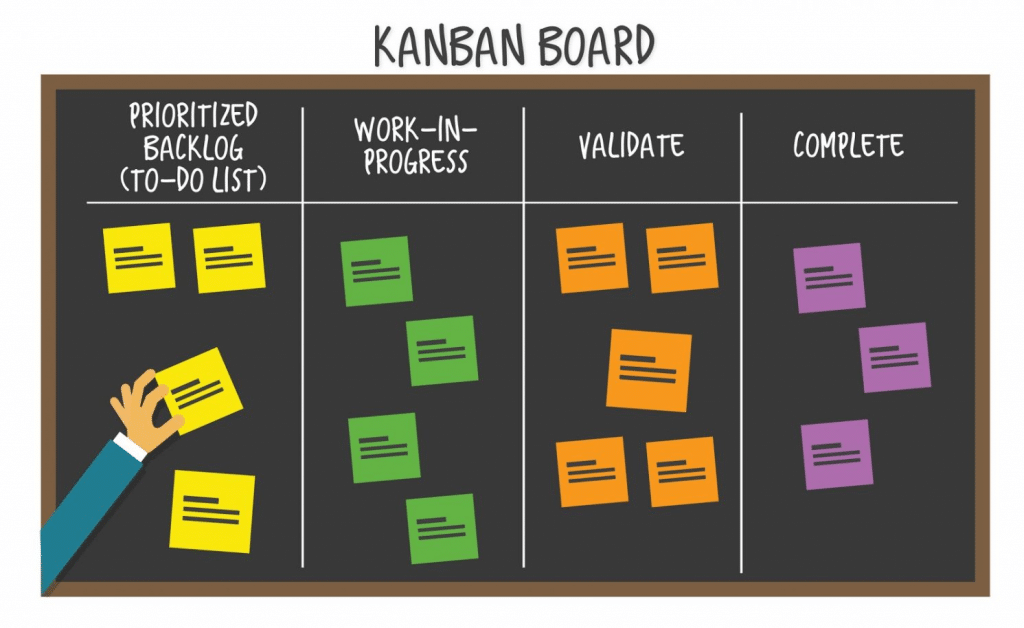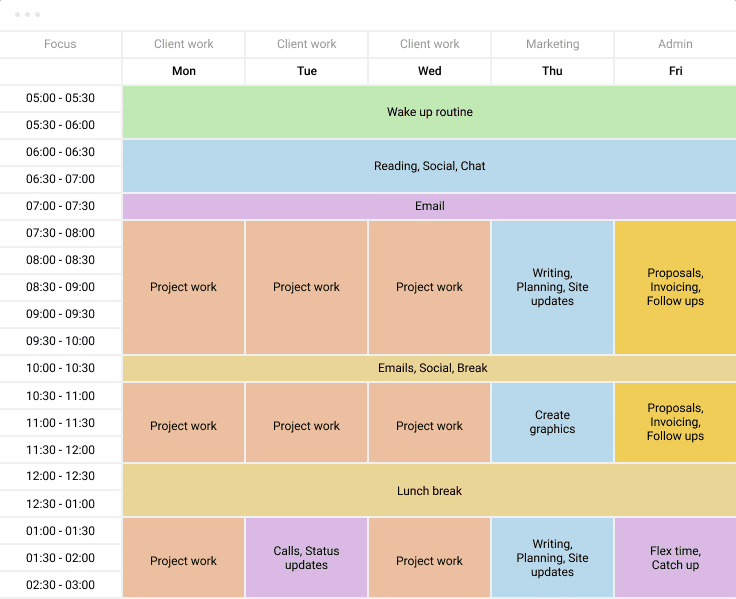If you’re an employee at a small or medium-sized business, you’re probably focused on being as productive as possible. After all, you’re the little guy—a David in a world full of Goliaths.
And as we all know, David didn’t topple Goliath by being bigger or stronger—he did it by being more efficient.
But without a plan or a system in place, “productivity” is often just a pipe dream. Something we’d all like to be, sure, but how do we get there? So, how can today’s small businesses empower the Davids in their ranks to get as much done as possible with what they have?

In this post, we’ll look at:
- How productivity is defined
- A history of productivity systems
- 9 productivity systems used by small businesses
What is “productivity?”
The standard definition of productivity is “a means of measuring efficiency.”
To measure productivity, you simply look at how much you’re getting out of something (units of output)—this could be the amount of goods created or money you made—and then divide it by how much you put in (units of input)—this could be time, money, or material goods:

For example, if you made $10,000 (units of output) from 20 hours of work (units of input), your productivity equals to $10,000 divided by 20 hours, which is $500 per hour.
For knowledge workers, that can sometimes be difficult to define—they can produce assets that are difficult to measure and frequently work on collaborative teams that can make individual contributions hard to gauge. It’s not as simple as just dividing units of output by units of input.
There are actually a few ways to measure productivity (more on productivity metrics) for knowledge workers—it’s just a matter of clearly defining the metrics that you want to measure and then making sure those are communicated and monitored.
For example, let’s assume we’re looking at a sales employee. You can measure their impact to the business in a number of ways:
- Volume-based: Let’s say your business simply prioritizes your sales agents completing as many calls as possible, regardless of the outcome of those calls. If that’s the case, agents are likely to simply focus on completing the highest volume of calls possible, which is the metric they’ll be measured and evaluated by.
“Productive” employees would be measured by the number of calls completed over a set amount of time.
- Conversion-based: If you want to optimize for impact, you could instead measure by the number of deals closed rather than the number of calls completed. This would encourage sales agents to focus on calling the customers most likely to convert, rather than just chasing a number of calls that may or may not convert at all.
Productivity by this standard might be measured by the amount of closed accounts compared to the number of calls made.
- Revenue-based: Optimizing yet again, we could go one step further and say that the volume of deals closed no longer matters, but the amount of revenue those deals brings in does.
By this standard, sales agents would be focused on the happy customers spending the most on your business—objectively the best way for your agents to be spending their time.
Using the examples above, let’s assume we have a sales agent who completes two calls in a week, resulting in one closed deal worth $20,000 in revenue. By the first and second measures, they would likely be considered a failure at worst and an underperformer at best.
But by focusing on revenue, which arguably (or maybe inarguably) has the biggest impact on your business, this employee is definitely productive compared to an employee bringing in less than $20,000 with more calls.
Regardless of role or department, by defining the metrics that matter most to your business and aligning those with individual roles, your employees will know what to optimize their production for.
And how do they do that? With productivity systems!
A history of productivity systems
As long as there has been work, there have been Davids—individuals focused on achieving their goals by making the most of the resources available to them. But, for the most part, these gregarious heroes of the workforce haven’t been able to just will productivity into existence—they’ve relied on tools to help them get more done. (We’re guessing they couldn’t just Google “productivity tips” back then.)
Benjamin Franklin, by all accounts a pretty productive guy, was a Founding Father and a prolific inventor. He founded the first volunteer firefighter company, hospital, and homeowner’s insurance company in the United States—and was also a renowned philosopher and orator. He may have also invented the first productivity framework with his (now famous) to-do list titled “What good shall I do this day?”
The list helped him map out his day, and probably helped contribute to the discovery of electricity and the invention of bifocal glasses.

The quest to be more productive continued in the early 1900s when department store owner John Wanamaker created the Wanamaker Diary, which helped a population that was increasingly shifting to industrial work keep better track of their days. Pretty cool stuff:

There would be few innovations to productivity tools beyond daily planners and calendars until the advent of the internet and mobile devices in the 1990s, including PDAs such as the Palm Pilot.

These days, productivity systems, tools, and apps are everywhere, helping millions of individuals and businesses around the globe better plan, prioritize, and manage resources.
9 productivity systems for small businesses
Life for today’s knowledge workers is increasingly busy and hectic, with an ever-growing list of personal and professional obligations, so it’s little surprise that so many productivity systems have sprung up to help them navigate them.
Broadly defined, productivity systems are any collection of processes, tools, and habits that people employ in the pursuit of being more productive. Productivity systems can encompass both physical tools, internal values and beliefs, and guiding frameworks to help the individuals and businesses using them achieve the end result of getting more done at the end of the day.
We’ll look at some of the more popular ones here and explain how they can be used in your business.
1. Getting Things Done
The most famous and long-lasting productivity system, Getting Things Done (or GTD) is a system developed by David Allen and made famous through a bestselling book. GTD essentially works by freeing the multitude of to-dos from inside your head and getting them out into the open where they can be prioritized.
How it works:
The framework is split into five steps:
- Capture (where you capture everything you have to do in one list)
- Clarify (ask yourself questions about every item to break out specific tasks or steps)
- Organize (once tasks have been clarified, prioritize, group, and add due dates)
- Reflect (frequently check your list to adjust necessary dates, remove redundant tasks, and update priorities as required)
- Engage (start tackling that list!)
The simplicity of this system has made it a global hit, with over 1.6 million copies of the book sold.
2. Kanban
A favorite of development teams everywhere, Kanban (or signboard) is a methodology developed by Toyota to improve manufacturing efficiency. Though most often associated with lean manufacturing, Kanban has gained popularity in other disciplines and industries thanks to the adoption of Agile methodology.
How it works:
Using a digital tool (like Trello or Jira) or a more hands-on approach (like a whiteboard or sticky notes), list out your projects on individual posts or cards and assign them to a category (such as to-do, backlog, doing, or done.)
By visualizing everything that needs to get done in one list, you’ll get better visibility into your to-dos and be able to prioritize and complete work more effectively. This methodology has been widely adopted by software development because of its ability to help teams visualize work and reduce work-in-progress time:

3. Time Blocking
As interruptions mount in the knowledge economy, their impact becomes more dramatic. It’s estimated that interruptions from work, whether in the form of questions, new requests, and notifications (like a new email) cost workers 40–60% of their time and the US economy $588 billion dollars each year.
Time blocking (or timeboxing) is gaining popularity as businesses and employees attempt to stave off distractions and ensure more time is spent focused on high-impact tasks.
How it works:
If you’re a fan of color-coded calendars, this is the system for you. Time blocking means adding absolutely everything to your calendar and making sure every task and to-do is accounted for and assigned a specific amount of time.
The benefit of this is two-fold: First, you get a visual representation of your to-do list on a tool that’s already on you most of the time (your calendar). Secondly, by assigning specific times to every task, you reduce the risk that tasks will turn into a massive time-suck and eat up your entire day. Once your time is up, you’re on to the next one.

4. The Action Method
The Action Method begins with a simple premise: everything is a project. Whether referring to creative campaigns, career development, or managing your finances, everything should be approached from a project mindset.
The Action Method was developed to help creatives move from the idea phase into the action phase with priorities, due dates, and assignments).
How it works:
The Action Method involves breaking projects into three categories:
- Action items
- Backburner items
- Reference items
Action Items are the steps you take to get the project done. Backburner Items are good ideas that might not necessarily be needed for THIS project.
And Reference Items are resources and information you need to complete the project—for example, creative briefs or email templates. By breaking each individual project down into these three categories, your business will be able to get more of them done.
5. The SMART Method
The SMART Method revolves around goal-setting in a way that turns big, ambitious ideas into measurable individual goals that keep people accountable. The SMART method is pretty popular, and widely used across organizations today.
How it works:
SMART is an acronym standing for “Specific, Measurable, Attainable, Relevant, and Time-Bound.” The SMART Method mandates that every business goal be tied to a specific objective, be able to be measured, be realistic, be relevant to business success, and should have a time limit placed on it.
For example: “I want our sales team to achieve $400,000 in new recurring revenue in this quarter” is a SMART goal, and looking at projects through this lens can help teams realistically figure out how they will measure success.
6. MoSCoW Method
The MoSCoW Method is a prioritization framework that can help people with choice paralysis (or prioritization problems) get more done by figuring out what really matters. Consider it a simplified version of the Eisenhower Matrix (more on this one below).
How it works:
It’s not just a clever name: the ‘MoSCoW’ stands for “Must, Should, Could, Would.” Write down absolutely everything you have to do today (or this week, or this month).
Then, go through the list and identify each as a Must (this is a non-negotiable and must be done), a Should (this is something that you need to do, but it’s not critical that it happen right now), and a Could (something that you’d like to do, but is unnecessary at this moment and can definitely be put off).
7. Eat The Frog
Eat The Frog is a productivity system founded on the belief that people will get stuck on one item that they hate doing, allowing it to derail their entire project/workload/job/life. If you’re a person that routinely misses deadlines on important projects, this may be for you.
How it works:
List out all of your daily tasks, then rank them from most difficult to easiest. Structure your days by tackling the most difficult tasks first and the easiest last; you’ll find that this helps fend off procrastination on important projects, improves the quality of your work (because you’re tackling important tasks while your energy is high), and your general mood improves (because you got the hardest work out of the way first.)
8. The Pomodoro Technique
Remember that stat about distractions and interruptions above? Well, what are you supposed to do if the distractions are coming from INSIDE THE HOUSE? The Pomodoro Technique is a great system for helping remain focused and rewarding yourself with distraction time after periods of uninterrupted work.
How it works:
Set a timer for 25 minutes. Work straight until that 25 minutes is up. Don’t check email, don’t respond to messages, do not pass Go, do not collection $200. When the 25 minutes is up, take a break for five minutes (check Instagram, grab a coffee, etc.)
Then, it’s back to work for another 25. Though 25 minutes can be too short a duration to really get into “deep work,” the flexibility of the pomodoro (Italian for tomato, because of the tomato-shaped timer the creator used to track his work) technique means you can adjust it based on your personal preferences (for me, it’s 50/10).
9. The Eisenhower Matrix
A more robust version of the MoSCoW Method, the Eisenhower Matrix is a visual representation of the Eisenhower Method, which General and former President Dwight Eisenhower used to prioritize and delegate tasks—and if it was good enough for him, it’s probably good enough for you.
How it works:
Take a piece of paper and split it into four quadrants (or use this template.) The horizontal “X” axis on this graph represents urgency, while the vertical Y axis represents importance. You should end up with four distinct areas:
- Urgent and Important (do now)
- Not Urgent and Important (schedule a time to do it)
- Urgent and Not Important (delegate to someone else)
- Not Urgent and Not Important (get rid of it)
Using this matrix, you can easily prioritize your most pressing tasks, and delegate and schedule the rest so that nothing slips through the cracks.

Bonus tip: Use the right tools to improve productivity
Here’s the thing. Building a productive workplace doesn’t just mean adopting one (or many) of the systems above—in order to help your team and business be as productive as possible, you have to have the right tools.

Because so much of productivity is dependent on clear communication, it’s critical that businesses use the right communication tools, and allow teams to share progress, provide status updates, communicate goals, or offer timely and relevant information can be the difference between a productive team and an unproductive one.
By pairing the right productivity system with the right communication tools, your business will be able to boost employee productivity and become the giant-killer you were always meant to be.
Choosing the right productivity system
We’re lucky enough to live in an era where there is a wealth of solid options available to businesses and individuals who are trying to be the most productive they can be.
The best productivity system for your business may be one specific choice, or a few stitched together, but by using the tactics described, you’ll be able to make the most of your time and get more done than ever before.
Updated Mar 13, 2025










